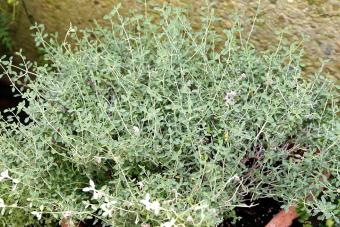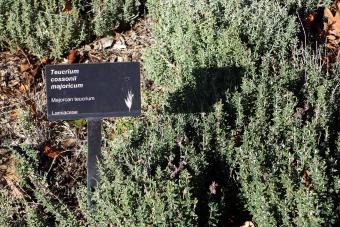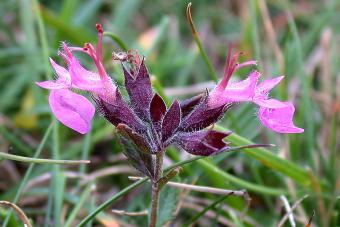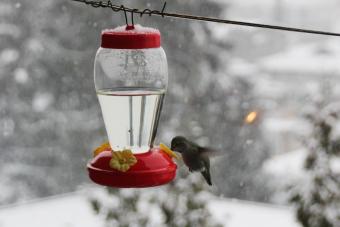
If you love the look of manicured knot gardens, or are looking for another beautiful, drought-tolerant addition to your landscape, consider planting germander. Its fragrant grayish-green foliage and tiny flowers make this plant an absolute delight to work with, whether you have a more formal garden, a cottage style garden, or something in between.
Growing Germander (Teucrium) in Your Garden
Germanders are perennials or low-growing shrubs. They can range from a few inches tall to several feet tall, depending on which type you're growing. While their flowers tend to be small, they are available in several colors and pollinators are very attracted to them. Overall, they're very easy to care for.

- Germander needs full sun and well-drained soil. This is a plant that grows very well, even in dry conditions. Soil that stays wet for extended periods of time isn't a good choice here, but other than that, this is a plant that tolerates most conditions.
- For its first year, it's a good idea to make sure that germander gets about an inch of water per week, which will encourage root growth and help it get established. After that, you really won't have to worry about watering unless your area experiences an extended drought.
- If germander is planted in nutrient-rich loam, it won't need any additional fertilizer. If you've planted it in sandy or less-fertile soil, it's a good idea to feed it in spring with a balanced fertilizer. You might also want to consider adding a layer of compost to the top of the soil for added fertility and water-retention.
Pruning Germander Plants
Germanders are pretty easy-going when it comes to pruning. If you enjoy shearing your plants into intricate shapes and hedges, they'll adapt to that wonderfully. Or, if you prefer having a more natural, cottage-style look to your garden, they don't need to be pruned other than to keep them the size you want and to remove dead stems or damaged foliage.
There is one case in which pruning might be a good idea. If the plant seems to be less vigorous after a few years and growth is sort of scraggly and just generally unimpressive, germanders can be cut down to six inches above soil level in early spring and they'll re-sprout, producing healthy, lush growth.
Propagating Germander
Germander can be grown from seed, sown four to six weeks before your last spring frost date. Germander seeds can take up to 30 days to germinate, so it does require a bit of patience. Start hardening the seedlings off after your last frost date, and then they can be planted directly into the garden.
Germander can also be propagated via cuttings.
- In spring, cut a four to six inch section from your plant. Make sure it has at least three leaves.
- Cut just below a leaf node, and strip any foliage from the bottom half of the cutting. This is what you'll be pushing into your growing medium.
- For the growing medium, an even mix of half coconut coir or peat to one half perlite is ideal. Moisten this before inserting your cuttings.
- Dip your cutting into rooting hormone, if you have it. This will help roots form more easily.
- Insert the cuttings so the bottom half is in the medium and gently firm around it, then water the cutting in.
- Place your pot inside a large clear plastic bag or upend a clear cup over the top. This will create a mini greenhouse to keep moisture in while your cutting is getting established.
- Place the containers in a bright spot but not in direct sun. If you have heating mats, set the container on those to speed root growth. Open the bag or top every few days to let it air out a bit.
- Water when needed, but don't overwater. If the soil is dry to the touch when you press a fingertip into it, give the cutting some water.
- Watch for new leaf growth, which is a signal that the cutting has successfully rooted.
- At this point, you can remove the clear plastic and start hardening your new plant off so you can plant it in the garden.
Types of Germander Plants
There are several different types of germanders, each with their own uses in the garden. They all need similar conditions: soil that stays on the medium to dry side and full sun.
Cat Thyme

Photo by David J. Stang, CC BY-SA 4.0, via Wikimedia Commons wikimedia commons Cat thyme
Cat thyme (Teucrium maru) is similar in appearance to common thyme but produces bright red flowers in summer and its scent is quite different--much more pungent. It grows to about 10 to 12 inches tall and is hardy in Zones 5 through 11. However, in colder zones, it'll need winter protection via evergreen branches or other mulch. If you live in a very dry climate, cat thyme grows best if given a little bit of shade during the hottest part of the day.
Felty Germander

Krzysztof Ziarnek, Kenraiz, CC BY 4.0, via Wikimedia Commons wikimedia commons Teucrium polium
Felty germander (Teucrium polium) is a dwarf whitish herb, 3 to 5 inches high, with small pale yellow flowers densely covered with short yellow down in June and July. It is best for sunny spots in the rock garden or any spot that has dry or sandy soil. Felty germander is hardy in Zones 6 through 9, and blooms in late summer through early fall.
Fruity Germander

Daderot, CC0, via Wikimedia Commons wikimedia commons Teucrium cossonii
Teucrium cossonii, known by its common name of "fruity germander," is a low-growing evergreen with grayish-green leaves that produces a four to six inch tall mat of dense foliage. It blooms from spring through fall, producing blooming clusters of lavender-colored flowers. Each plant spreads two to three feet, making this an excellent groundcover for hot, dry areas. Fruity germander is hardy in Zones 8 through 10.
Mountain Germander

CC BY-SA 3.0, via Wikimedia Commons wikimedia commons Teucrium montanum
Mountain germander (Teucrium montanum) produces an abundance of pale yellow flowers on its dense carpet of green, fragrant leaves. It grows to about 12 inches tall, and is hardy in Zones 6 through 9. It's an excellent choice for edging, rock gardens, or to grow in troughs.
Pyrenean Germander

Bernard DUPONT from FRANCE, CC BY-SA 2.0, via Wikimedia Commons wikimedia commons Teucrium pyrenaicum
Pyrenean germander (Teucrium pyrenaicum) is a dwarf hardy perennial with trailing stems 3 to 7 inches high, and purplish and white flowers in dense terminal clusters. The leaves, branches, and stem are thickly covered with soft silvery down. It is wonderful in rock gardens and for borders. Pyrenean germander is hardy in Zones 7 through 10.
Tree Germander

A. Barra, CC BY-SA 4.0, via Wikimedia Commons wikimedia commons Teucrium fruticans
Tree germander (Teucrium fruticans) is a small tree or large shrub that's native to the Mediterranean. It has white stems and with green leaves with silvery undersides, and produces pale blue flowers that are very attractive to bees and other pollinators. Tree germander grows from four to eight feet tall and is hardy in Zones 8 and 9.
Wall Germander

Len Worthington, CC BY-SA 2.0, via Wikimedia Commons wikimedia commons Wall Germander
Teucrium chamadrys, better known as wall germander, grows in low clumps, its stems covered with shiny green leaves. Both the leaves and the flowers (which are light purple and appear from late summer through early fall) are fragrant and commonly used in potpourris, wreaths, and flower arrangements. It grows to about 12 inches tall and 12 to 24 inches wide, and is attractive in all seasons due to the fact that it's an evergreen. Wall germander is hardy in Zones 5 through 9.
Water-Wise Beauty
If you're trying to conserve water in your landscape, germanders make an excellent addition. Their low-maintenance qualities, as well as the fact that they not only survive, but thrive, in dry conditions, along with their beauty, make germanders plants worth growing.







